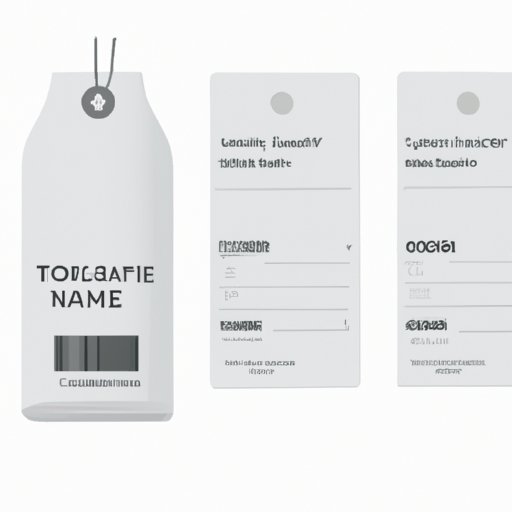Introduction
A white label business is a great way to enter the market without having to invest in costly resources and materials. It involves reselling products or services created by another company under your own brand name. By leveraging existing products, you can quickly launch a business without having to develop anything from scratch. In this article, we’ll explore the steps involved in starting a white label business.

Research White Label Business Models
Before you can start a white label business, you need to decide which type of model you want to pursue. There are several different types of white label business models, each with its own advantages and disadvantages. Here are some of the most common models:
Types of White Label Business Models
- Drop Shipping: Drop shipping involves selling products directly to customers without having to store any inventory. You simply purchase the items from a supplier and then have them shipped directly to the customer.
- Affiliate Marketing: With affiliate marketing, you promote other companies’ products or services on your website. When someone clicks on one of your links and makes a purchase, you receive a commission.
- Private Labeling: Private labeling involves buying products from a manufacturer and then reselling them under your own brand name. You can customize the products to your liking, such as adding your own logo or changing the colors.
- White Label Services: White label services involve providing services such as web design or SEO under your own brand name. You may purchase these services from a third-party provider and then resell them to your clients.
Each of these models has its own set of benefits and drawbacks. It’s important to analyze your options carefully and choose the model that best suits your needs.
Analyzing Your Options
Once you’ve identified the type of white label business model you’d like to pursue, it’s time to do some research. Take a look at the competitors in the space and compare their offerings. What are they doing differently? Are there any areas where you could improve upon their offerings?
It’s also important to consider the costs associated with each model. For example, if you’re planning on drop shipping, you’ll need to factor in shipping costs as well as any fees associated with the supplier. If you’re offering white label services, you’ll need to calculate the cost of hiring additional staff and the cost of providing the services themselves.
Identify Potential Suppliers
Once you’ve decided on the type of white label business model you’d like to pursue, it’s time to find potential suppliers. This is an important step, as it will determine the quality of the products or services you provide.
Researching and Evaluating Potential Suppliers
When researching potential suppliers, it’s important to look for ones that have a good reputation. Take a look at customer reviews and see what people are saying about the company. You should also contact the supplier directly and ask questions about their product or service. This will give you a better understanding of the quality of their offerings.
It’s also important to evaluate the supplier’s pricing structure. Make sure you understand all of the terms and conditions associated with their pricing model. It’s also a good idea to compare prices across multiple suppliers to make sure you’re getting the best deal.
Developing Relationships with Suppliers
Once you’ve identified potential suppliers, it’s important to establish strong relationships with them. This can be done through regular communication, such as phone calls or emails. You should also attend trade shows and industry events to build your network and meet new potential suppliers.
Having a good relationship with your suppliers will ensure that you receive quality products and services that meet your standards. It will also help you negotiate better terms and prices, which will ultimately benefit your business.
Create a Branding Strategy
Once you’ve identified potential suppliers, it’s time to create a branding strategy for your business. Your brand should reflect your values and mission, and it should be something that resonates with your target audience.
Establishing Your Brand
The first step in creating a branding strategy is to establish your brand. Think about what makes your business unique and what sets you apart from the competition. Develop a mission statement that outlines your core values and principles.
Crafting an Effective Brand Message
Once you have established your brand, it’s time to craft a message that resonates with your target audience. Think about the specific benefits your products or services provide and how they address the needs of your customers. Keep your message concise and compelling.
Utilizing Visual Elements to Enhance Your Brand
In addition to crafting an effective brand message, it’s important to utilize visual elements to enhance your brand. This can include things like logos, colors, fonts, and images. All of these elements should work together to create a cohesive and recognizable brand identity.
Develop a Pricing Model
Once you have established your brand and crafted an effective message, it’s time to develop a pricing model for your business. This is an important step, as it will determine how much profit you make from each sale.
Assessing Your Costs
Before you can set your prices, you need to assess all of your costs. This includes the cost of purchasing products or services from your suppliers, as well as any overhead costs such as shipping and taxes. Once you know your total costs, you can then begin to set your prices.
Setting Your Prices
When setting your prices, it’s important to keep in mind the value that your products or services provide. Don’t be afraid to charge a premium for higher quality products or services. Just make sure that your prices are competitive and that you’re making a reasonable profit.
Create an Online Storefront
Once you have established your brand, crafted an effective message, and determined your pricing model, it’s time to create an online storefront. This is the place where customers can easily browse your products and make purchases.
Choosing the Right Platform
There are many different platforms available for creating an online store, so it’s important to choose the right one for your business. Consider factors such as cost, ease of use, and features when making your decision. Research each platform to determine which one best meets your needs.
Enhancing Your Storefront with Visuals
Once you’ve chosen a platform for your online store, it’s time to start thinking about how to make it stand out. Utilize visuals such as high-quality product photos and videos to make your store more appealing to customers. You should also consider using interactive elements such as customer reviews and ratings to encourage engagement.

Utilize Social Media for Promotion
Social media is a powerful tool for promoting your business. It allows you to reach a larger audience and engage with potential customers in real-time. Here are some tips for leveraging popular social media platforms for promotion:
Leveraging Popular Social Media Platforms
Start by establishing profiles on the most popular social media platforms such as Facebook, Twitter, and Instagram. These platforms have large user bases and can help you reach a wider audience. Make sure to post regularly and interact with your followers to keep them engaged.
Creating Engaging Content
When creating content for your social media pages, focus on creating content that is engaging and informative. Post photos and videos of your products or services, and offer discounts and promotions to encourage sales. You should also respond to customer inquiries and feedback in a timely manner.
Analyze and Adjust Your Strategy
Finally, it’s important to analyze and adjust your strategy as needed. Monitor your results and track key metrics such as website traffic and sales. Use this data to identify areas for improvement and make adjustments as necessary.
Conclusion
Starting a white label business can be a great way to enter the market without having to invest in costly resources and materials. By leveraging existing products and services, you can quickly launch a business without having to develop anything from scratch. However, it’s important to take the time to research potential models, identify potential suppliers, create a branding strategy, develop a pricing model, create an online store, and utilize social media for promotion. Finally, don’t forget to monitor your results and make adjustments as necessary.
(Note: Is this article not meeting your expectations? Do you have knowledge or insights to share? Unlock new opportunities and expand your reach by joining our authors team. Click Registration to join us and share your expertise with our readers.)
